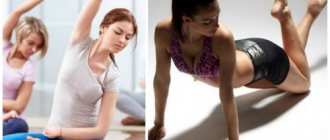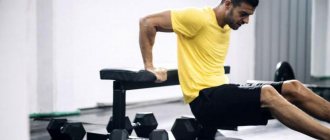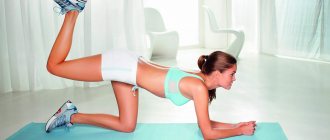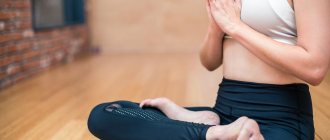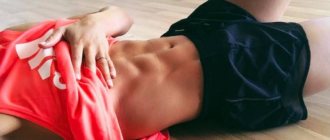Technique for performing pull-ups on the bar Errors when performing the exercise
Table of points for performing the pull-up exercise on the barPull-up training on the bar
Introduction to the exercise
Learning the exercise
Workout exercise
Technique for performing pull-ups on the bar
Hanging on the bar (in a stationary position, overhand grip, arms, body and legs straight), bending your arms, pull yourself up (chin above the bar), straightening your arms, lower yourself into a hanging position.
The hanging position is fixed for at least 1 second. (continue driving after the score is announced).
It is allowed to spread your legs to shoulder width and slightly bend your legs at the hip and knee joints.
It is forbidden to perform the exercise with a jerk or swing.
The exercise is performed using the command “TO THE PROJECTILE”.
If the exercise technique is violated, the repetition is not counted and the command “DO NOT COUNT” is given.
Organization of insurance.
Standing at the side and slightly behind the student and without touching him, hold one hand in front of the thigh, and the other one in the back near the lower back. Be prepared to hold the student if he falls off the crossbar.
Touching the student is allowed only to stop the swinging of the body.
Correct pull-up technique for working your back muscles
Pull-ups are the same vertical row, but here it’s not the handle that comes towards us, but we pull ourselves up to the horizontal bar. And the basic rule is that the load vector must pass through the chest. Not along, but through the chest. How to achieve this?
A mental principle can help you. Someone mentally reaches for the horizontal bar, that is, tries to pull their body towards the crossbar, while someone mentally pulls the horizontal bar towards themselves. If you imagine, hanging on the horizontal bar, these two moments in turn, then you will notice a difference in the actual mood for pulling up. This method helps to set up the correct motivation of the nervous system to perform the exercise. Therefore, you need to choose your own way of imagining what exactly you are doing, pulling yourself up to the horizontal bar or pulling the horizontal bar towards you.
Head position in pull-ups
In order for the back and arms to receive the maximum possible neuromuscular impulse, all unused muscles must be disconnected from the efforts of the nervous system. The position of the head in this exercise depends on the condition of the neck. When doing pull-ups, you need to relax your neck as much as possible so that your head leans back. You should not look at the horizontal bar while doing pull-ups. And you need to throw your head back and look at the ceiling.
Leg position for pull-ups
You don’t need to move your legs forward or keep them straight. The legs need to be bent at the knees back and crossed to create a rigid structure.
When we pull ourselves up, we do not pull our chin toward the horizontal bar, but rather pull our chest toward the horizontal bar or pull the horizontal bar toward our chest (it all depends on which imaginative option you have chosen for yourself). During pull-ups, you need to protrude your chest as much as possible in the direction of the horizontal bar (this is very important).
The perfect pull-up is not at all like the usual pulling of the chin over the bar.
An ideal pull-up should be similar to a vertical row in a block. You should eventually bring the bar to the lower or upper part of the pectoral muscles. It all depends on the grip you choose: reverse or forward grip. That is, you need to try to pull the thoracic part of the body towards the horizontal bar, and the rest of the body should just hang.
What to do if it never works out well?
We use a strength method called “rest-pause,” which will help increase your own strength resources even between approaches within the same workout.
We do one pull-up, even with an assistant, and rest while standing on the floor, not hanging, for 10 seconds. Then we hang on the horizontal bar again, pull ourselves up once again with the help of an assistant, and rest again. And thus we do 6-8 repetitions. Several cycles of such pull-ups over 1-2 months and you will be able to do pull-ups on your own. Just keep in mind that this is possible if your weight is normal and there is no excess fat mass, that is, no more than 15%. Then this will guarantee you results, and if you have a lot of fat, then you need to lose weight.
Grip
Let's start with the fact that people with naturally large biceps and a narrow back should not do pull-ups with a reverse or parallel narrow grip. Because such a person will still not load his back, and his body weight will be pulled by his biceps. Therefore, a person gifted with large arms and a depressed back needs to pull himself up with a wide overhand grip.
If everything seems to be fine with your back, but your arms are lagging behind, then you need to use the opposite strategy. To learn how to pull yourself up effectively, you need to use your hands to help your back. This way the arms can develop together with the back, in a balanced way. There is no risk that the arms will take the entire load on themselves and will not allow the back to work, because such a person’s arms are genetically weak.
Interesting to know: pull-ups are one of the best exercises for training your biceps. As proof, look at the gymnasts who perform on the rings and uneven bars, these guys just have colossal arms.
Pull-ups with weights
When you have already learned and it becomes a question of making this exercise heavier, you can use additional weight. When doing pull-ups with weights, it is better to hang the weight from behind, so that the weight does not throw off your balance. When using the correct pull-up technique (where the chest is pulled towards the bar, not the chin), the weight suspended in front will greatly interfere. He will put pressure on his legs and try to twist his body into a vertical position. Therefore, it is better to hang weights for pull-ups from behind, so it will hang parallel to your legs and will not interfere with your workout.
Mistakes when performing the pull-up exercise
Exercise 17 Forward somersault
Minor - Minor bending and spreading of the legs is allowed.
Significant - Hands on the bar are at a distance greater than shoulder width. Pull-ups are performed from a hanging position with a reverse grip. Jerks and swinging movements are made with the legs. The chin touches the crossbar. Pushing off the floor and touching other objects is allowed. A sharp upward movement of the head, interceptions and opening of the palm are performed. In the starting position, the arms are bent at the elbow joints, and when moving up, the legs are bent at the knee joints. The arms are bent alternately. The exercise is interrupted by a significant rest stop.
Hanging on bent arms with leg lift[edit | edit code]
This movement, which combines a pull-up with a hang hold, provides a great workout for the biceps, trapezius, latissimus dorsi, and midsection muscles. Reduce the tendency to sway by tightening your abdominals and lower back muscles.
- Grab the bar with an underhand grip, your hands slightly narrower than shoulder-width apart, and assume a hanging position. Squeeze your shoulder blades and pull yourself toward the bar until your elbows are at approximately 90 degrees. Hold this position.
- As you exhale, raise your knees to your elbows.
- In a slow, controlled motion, lower and straighten your legs.
OPTION
. For additional work on the midsection, after raising your knees to your elbows, straighten your legs, lower them parallel to the floor and try to hold the “corner”.
Log of the 50 Pull Ups in 7 Weeks Program: Phase I
| A WEEK | DAY | APPROACH 1 | APPROACH 2 | APPROACH 3 | APPROACH 4 | APPROACH 5 | TOTAL | MAX. QTY | |||||
| Target | Fact | Target | Fact | Target | Fact | Target | Fact | Target | Fact | ||||
| 1 | Mon | ||||||||||||
| SR | |||||||||||||
| PT | |||||||||||||
| IN JUST A WEEK | |||||||||||||
| 2 | Mon | ||||||||||||
| SR | |||||||||||||
| PT | |||||||||||||
| IN JUST A WEEK | |||||||||||||
| 3 | Mon | ||||||||||||
| SR | |||||||||||||
| PT | |||||||||||||
| IN JUST A WEEK | |||||||||||||
| 4 | Mon | ||||||||||||
| SR | |||||||||||||
| PT | |||||||||||||
| IN JUST A WEEK | |||||||||||||
| 5 | Mon | ||||||||||||
| SR | |||||||||||||
| PT | |||||||||||||
| IN JUST A WEEK | |||||||||||||
| 6 | Mon | ||||||||||||
| SR | |||||||||||||
| PT | |||||||||||||
| IN JUST A WEEK | |||||||||||||
| 7 | Mon | ||||||||||||
| SR | —- , | ||||||||||||
| PT | |||||||||||||
| IN JUST A WEEK | |||||||||||||
| PHASE TEST! | A | 1| | |||||||||||
Log of the 50 Pull Ups in 7 Weeks Program: Phase II
| A WEEK | DAY | APPROACH 1 | APPROACH 2 | APPROACH 3 | APPROACH 4 | APPROACH 5 | TOTAL | MAX. QTY | |||||
| Target | Fact | Target | Fact | Target | Fact | Target | Fact | Target | Fact | ||||
| 1 | Mon | ||||||||||||
| SR | |||||||||||||
| PT | |||||||||||||
| IN JUST A WEEK | |||||||||||||
| 2 | Mon | ||||||||||||
| SR | |||||||||||||
| PT | |||||||||||||
| IN JUST A WEEK | |||||||||||||
| 3 | Mon | ||||||||||||
| SR | |||||||||||||
| PT | |||||||||||||
| IN JUST A WEEK | |||||||||||||
| 4 | Mon | ||||||||||||
| SR | |||||||||||||
| PT | |||||||||||||
| IN JUST A WEEK | |||||||||||||
| 5 | Mon | ||||||||||||
| SR | |||||||||||||
| PT | |||||||||||||
| IN JUST A WEEK | |||||||||||||
| 6 | Mon | ||||||||||||
| SR | |||||||||||||
| PT | |||||||||||||
| IN JUST A WEEK | |||||||||||||
| 7 | Mon | ||||||||||||
| SR | |||||||||||||
| PT | |||||||||||||
| IN JUST A WEEK | |||||||||||||
| 50 PULL UP TEST | |||||||||||||
Push Up Preparatory Program Log
| A WEEK | DAY | APPROACH 1 | APPROACH 2 | APPROACH 3 | APPROACH 4 | APPROACH 5 | total | MAX. QTY | |||||
| Target | Fact | Target | Fact | Target | Fact | Target | Fact | Target | Fact | ||||
| 1 | Mon | ||||||||||||
| SR | |||||||||||||
| PT | |||||||||||||
| IN JUST A WEEK | |||||||||||||
| 2 | Mon | ||||||||||||
| SR | |||||||||||||
| PT | |||||||||||||
| IN JUST A WEEK | |||||||||||||
| 3 | Mon | ||||||||||||
| SR | |||||||||||||
| PT | |||||||||||||
| IN JUST A WEEK | |||||||||||||
| 4 | Mon | ||||||||||||
| SR | |||||||||||||
| PT | |||||||||||||
| IN JUST A WEEK | |||||||||||||
| 5 | Mon | ||||||||||||
| SR | |||||||||||||
| PT | |||||||||||||
| IN JUST A WEEK | |||||||||||||
Table of points for performing the pull-up exercise on the bar
| Points | Col. once | Points | Col. once | Points | Col. once | Points | Col. once | Points | Col. once | Points | Col. once |
| 100 | 30 | 90 | 25 | 80 | 20 | 70 | 15 | 50 | 10 | 30 | 5 |
| 98 | 29 | 88 | 24 | 78 | 19 | 66 | 14 | 46 | 9 | 26 | 4 |
| 96 | 28 | 86 | 23 | 76 | 18 | 62 | 13 | 42 | 8 | 22 | 3 |
| 94 | 27 | 84 | 22 | 74 | 17 | 58 | 12 | 38 | 7 | 16 | 2 |
| 92 | 26 | 82 | 21 | 72 | 16 | 54 | 11 | 34 | 6 | 6 | 1 |
Note: The standards presented in the table correspond to sportswear: 1C (swimming trunks, shorts, T-shirt, sports shoes). In this form, by decision of the commander (chief) of a military unit (military educational institution), under appropriate conditions, it is allowed to practice without a T-shirt and shoes; 2C (in shorts, T-shirt, sports shoes); 3C (in a sports (training) suit, sports shoes); 4C (in an insulated sports (training) suit, insulated sports shoes, a sports hat).
Pull-ups for endurance
When developing endurance on the crossbar, use your own body weight.
It is believed that after endurance training, the human body recovers within a day.
Classic exercises for developing general endurance are:
- walking
- run
- a ride on the bicycle
- swimming
These are regular cardio exercises where the body functions in an aerobic mode.
Their standard duration is 40-60 minutes. In this case, the process continues continuously. During this time, the muscles contract thousands of times.
Pull-ups on the horizontal bar do not involve such work.
Here we are not talking about general endurance, but about strength endurance - the ability to perform strength work for a long time.
Therefore, the recovery time for muscles and the body as a whole will differ.
A suitable frequency for developing strength endurance on the horizontal bar is considered to be training every other day. That is, 3-4 times a week.
The same rule applies to terrain training. The optimal frequency of training here is 2-3 times per weekly cycle.
Correct technique for performing the exercise.
It is extremely difficult to get injured doing pull-ups, but this does not mean that there is no need to follow the correct technique. Basically, the correct technique is necessary in order for there to be a result. If you do pull-ups incorrectly, the muscles will not be pumped and you will not get the expected effect from the exercise.
How to do pull-ups on the horizontal bar:
- Place your hands at shoulder level and straighten your body, keeping it in good shape.
- Pull yourself up with your arms, do not help yourself with your body and do not make sudden movements.
- Tuck your elbows under you. Pull yourself up until your chin is above the horizontal bar.
- You should not go down suddenly. Return to the starting position also slowly.
- Spread your arms. This means you have completed one set.
You should not chase after experienced athletes and do pull-ups without fully straightening your elbows. Initially, you should do the usual type of pull-ups, and only then improve the technique. You can select a horizontal bar using the link.
Exercise training No. 5 (lifting legs to the bar)
Exercise 5. Raising legs to the crossbar.
Hanging with an overhand grip; raise your legs to the bar until they touch the bar and lower them down. The hanging position is fixed. It is advisable to carry out training in performing strength exercises on the crossbar using the repeated method or the maximum effort method.
The number of repetitions of the exercise in one approach depends on the level of the current individual indicators of the student, which must be taken into account by the commander. Training by the repeated method consists of repeating the exercise many times with the same power (the amount of effort should be no more than 60 percent of the maximum).
Training using the maximum effort method is carried out after 3-4 training sessions using the repeated method. In training, when the practitioner performs an exercise with maximum effort, it is sometimes advisable to provide assistance in the final stage of the approach in order to overcome the psychological barrier of a certain number of repetitions.
You should not stop at achieving the regulatory requirements of the Manual on Physical Training. It is always necessary to create a reserve of motor abilities, guaranteeing the necessary level of preparedness. The maximum effort method is characterized by performing exercises in such a way that the soldier shows the maximum strength of which he is currently capable.
Maximum effort refers to the maximum resistance training weight that a student can lift (perform) without significant emotional arousal. An example of the application of this method can be estimates and checks by the commander of the level of strength development (performing strength gymnastic exercises).


